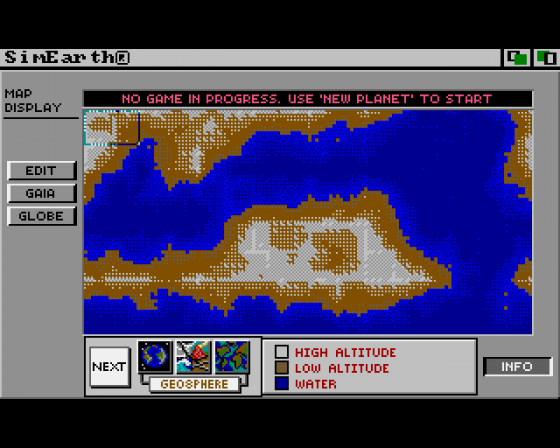
The One
 1st December 1990
1st December 1990
Categories: Review: Software
Author: Laurence Scotford
Publisher: Ocean
Machine: Amiga 500
Published in The One #27
Having allowed you to tinker with a city or two, Maxis now gives you whole worlds. Laurence Scotford takes up the challenge to become an apprentice god.
Sim Earth (Ocean)
Maxis' first 'software toy' was SimCity, released during 1989. It was one of the two most original pieces of entertainment software released that year, and, like Populous, SimCity gives the player god-like powers.
The idea behind Software Toys is that, unlike most other forms of entertainment software, they are open-ended. There is no set objective as such. SimCity allows players to try their hands at running a city, either building one up from scratch or starting with a pre-set scenario. This involves manipulation of the many elements that affect the development of cities and also handling crises from fires to sea monsters.
SimEarth takes the basic principles behind SimCity and applies them to whole planets. Now you are given the opportunity to set yourself up as a deity and control the way each planet develops. This is achieved by using tools to adjust the Earth's four elements: the Lithosphere, Atmosphere, Hydrosphere and Biosphere.
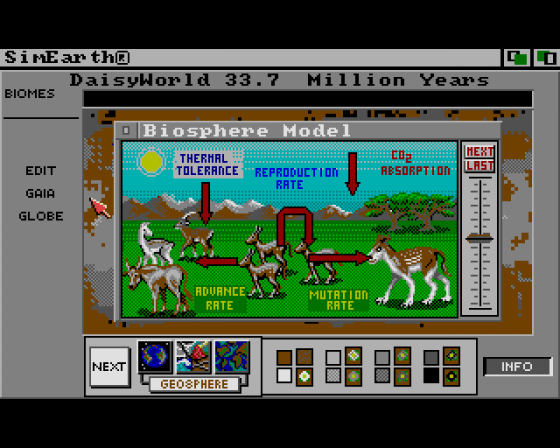
The SimEarth model is based on the Gaia Hypothesis, which was originated by eminent scientist James Lovelock. He believes that the Earth can be seen as a single organism that has generated a self-regulatory mechanism to ensure that life on the planet survives and continues to evolve.
A rather neat way of showing how you are doing is the Gaia window. This shows the planet's face changing state from absolute misery to complete bliss. Keep the window on screen and the eyes follow the pointer as it moves. It really is as if Mother Earth herself is watching you.
The Gaia Hypothesis
Gaia is an extraordinary, simple and beautiful way of looking at something apparently very complex: the evolution of the Earth. It sees the Earth as being a single organism in which the evolution of animal and plant life and the shaping of land, sea, and atmosphere are all tightly coupled processes. Events that affect_one aspect of the Earth's evolution have a corresponding effect on all other aspects.
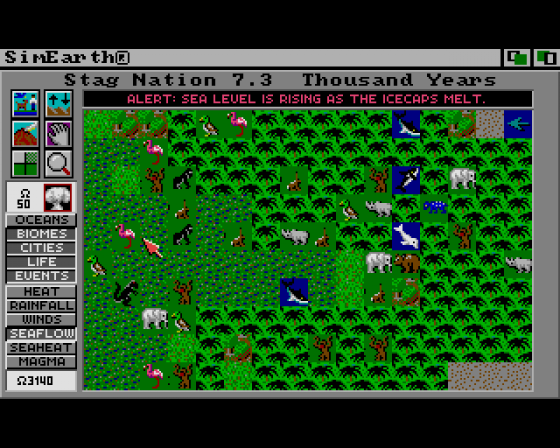
This remarkable view of our planet was originated by distinguished scientist James Lovelock 25 years ago. At the time he was working for NASA's Jet Propulsion Laboratories. Even in 1966 they were already planning unmanned space missions to Mars, and one of the most exciting aspects of that mission was Life Detection. James Lovelock was assigned to that very project.
He soon became aware that each scientist on the team was looking for life in terms of individual disciplines. A bacteriologist for instance, would want to set up an Earth type laboratory with Petri dishes for the collection of soil and growth of bacteria.
James Lovelock thought this was not a sensible way of going about their task. Life on Mars might be very different to the lifeforms we are familiar with on Earth. Also, the craft might land at a point on the planet that is devoid of life. This would be like an alien culture sending a crewless spacecraft to Earth and having it land in the Arctic. They might, wrongly, get the impression that Earth was a lifeless, frozen waste.

So he began to ask himself whether there was a foolproof way of identifying a planet that supported life. He came to the conclusion that any life would show up as a slowing down or reversal of Entropy (the measure of disorder in natural system - most natural systems move from an highly active state to a stable inactive state).
One of the ways that life is evident on Earth is the composition of the atmosphere. There is a much higher concentration of Carbon Dioxide than there would be in atmosphere that is not being breathed (and consequently changed) by lifeforms. James Lovelock proposed to NASA that they could determine whether there was life on Mars simply by analysing the atmosphere with an Infra-Red telescope. This was an unusual top-down approach to looking for life: an attempt to analyse the whole rather than the parts. It was this that led James Lovelock to apply a similar view to the Earth.
Looking at the Earth in this way uncovers some remarkable facts. The Earth's climate has remained stable and able to support life for millions of years, despite the sun's heat having risen by 25 per cent over that time. How can this be explained? Certainly not by trying to analyse the physical, chemical, and biological factors in isolation. But by considering the Earth as a whole - a single complex organism - it is easy to see how it regulates itself in much the same way as our own body temperature is regulated.

It was the novelist William Golding (author of The Lord Of The Flies) who attached the name 'Gaia' to James Lovelock's hypothesis. Gaia was the Ancient Greeks' way of expressing the concept of 'Mother Earth' and seems appropriate to the view of the planet taken by James Lovelock.
Could the Gaia hypothesis be extended beyond the Earth and applied to other planets - or even solar systems or the universe itself?
Recognising other systems comparable to our own is simply a matter of looking for the slowing down of entropy, just as James Lovelock proposed we look for life on Mars. Dead planets are more likely to have attained a more stable chemical state over their millions of years of existence whereas planets are more likely to have attained a more stable chemical state over their millions of years of existence whereas planets that support life show signs of unlikely chemical activity in their atmosphere, hydrosphere, and lithosphere.
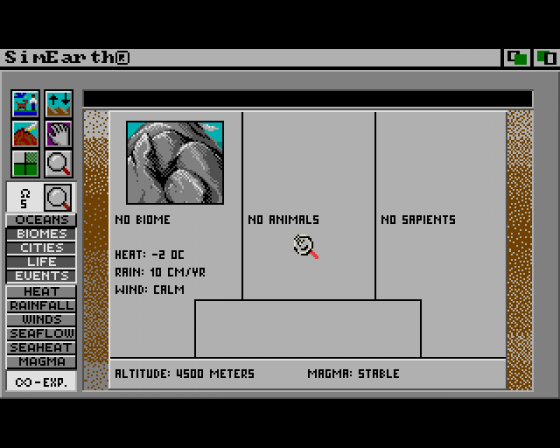
According to James Lovelock, it would not be fair to apply the Gaia hypothesis to star systems, galaxies and the like, because although they may include individual life-bearing planets they are still moving as a whole towards states of equilibrium (this is entropy at work again).
Quantum physics states that, at a sub-atomic level, even a chemically stable universe is really a seething sea of energy with particles receiving and losing energy levels and even being created and destroyed. Some physicists have proposed that every event in the universe is linked to every other event in the universe via this cosmic web. Could it be that this process is what ultimately drives Gaia? "It's always very interesting to speculate like this," says James Lovelock, "but I have always been a practical scientist and I'm more interested in theories that we can directly apply now to the real world".
One of the most interesting aspects of Gaia is the role that we play. Does intelligent man aid the process, or is he but a spanner in the works? Man certainly does seem to fulfil a paradoxical role as part of this single organism. Sometimes he is like a cancer, and other times he behaves like an antibody.
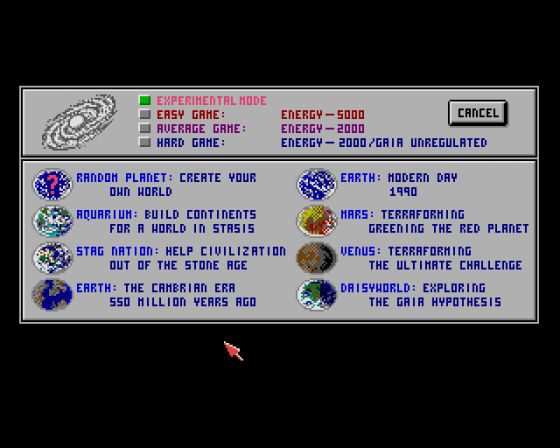
"I think there is a lot of hubris in the way we look at ourselves," exclaims James Lovelock. "We think we are far more important than we actually are. Of course we are damaging the environment and in doing so we are not safeguarding our own future. But nothing we do will upset Gaia in the long term. There will be higher lifeforms to succeed us. Perhaps, when the planet becomes too hot to support carbon-based life some form of silicon.
We asked James Lovelock how he came to be involved in the SimEarth project: "Stewart Brand, the former editor of Co-Evolution Quarterly, is a friend of mine and lives near Will Wright of Maxis. When Will suggested doing SimEarth, Stewart recommended that Will contacted me, and he did."
James' function in the project was "to give advice. I particularly provided help with geophysical modelling. Attempts to model the Earth through single sciences such as biology or biochemistry fail because the models are oversensitive to initial conditions and prone to chaotic disturbance. Gaia models, where the biology and the geology are tightly coupled, are for some reason stable and able to resist perturbations."
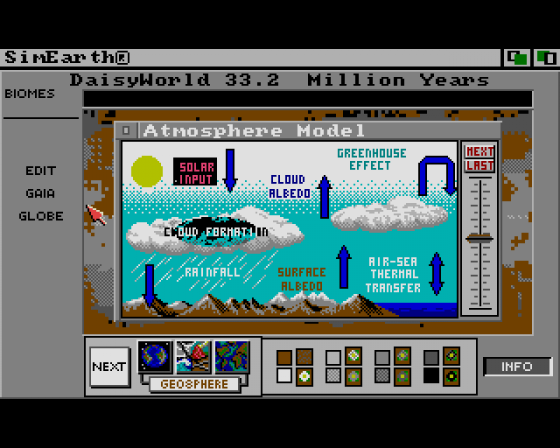
Do you think that computers can ever manage to simulate such a complex and variable system with any great degree of realism?
"Yes I do. I am amazed at how well SimEarth does considering that it is little more than a game."
Are there any other ways that we can observe and better understand the Gaia hypothesis in action?
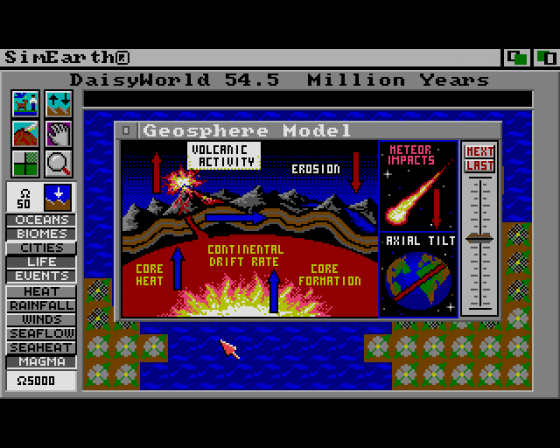
"The other and essential way to understand the world is to observe it and see if the predictions from models such as these map onto the real world."
How well does SimEarth manage to encompass the many variables that are part of Gaia?
"That is up to the player to discover. Don't forget that SimEarth allows the user to manipulate the conditions and variables."

Have you ever been involved in any other computer simulations of natural processes on this scale?
"No, and nor has anyone else! The great climate models that use super computers look only at the atmosphere. Most of them don't even include clouds and none of them take into account the ocean or the biology."
PC
There are a whole host of options to allow this version to work most configurations of the machine, but, as is more often than not the case, maximum benefits obtained from having a bit of speed (80286 or better) and either an EGA or VGA card. As the simulation operates using a WIMP style system, a mouse is pretty much essential (it's worth spending the extra to buy one, just to play this simulation). A hard disk also comes in handy to avoid tedious disk accessing.
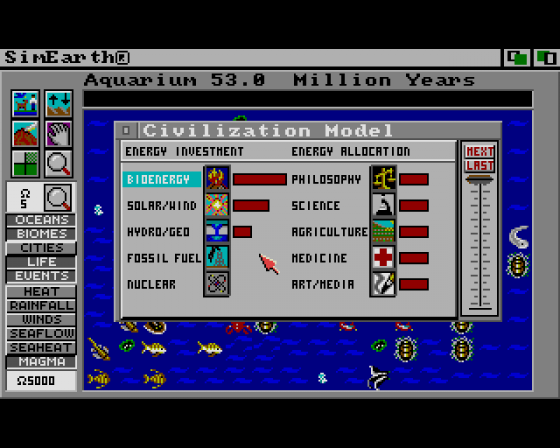
The beauty of SimEarth is that you can have hours of fun experimenting with it before you even read a page of the manual. Then you can sit and absorb the informative (but far from amusing) manual and have hours of fun experimenting and understanding what you are doing.
This is not a program you are ever likely to relegate to the top shelf. Once you have played through all the pre-set scenarios provided there are near-infinite variations with which to experiment. Of course, SimEarth has tremendous educational possibilities, but it is also fun to use. It's gratifying to see that Maxis has taken its subject seriously without taking things too far (there are many neat touches, such as the inclusion of the black monoliths from 2001: A Space Odyssey).
Even if you don't agree with the Gaia Hypothesis, SimEarth has an enormous amount to offer when it comes to long-term stimulating entertainment.
ST
Details are scarce at present, but there is no reason why everything that is implemented on the PC version should not be available to Amiga owners. Obviously if you have a basic machine you are going to have to put up with a lot more disk accessing, but at least it's worth the wait.
Amiga
For this one read as the Amiga. It's very doubtful that there will be any detrimental differences between the two versions.
Other Reviews Of Sim Earth For The Amiga 500
Sim Earth (Ocean)
The Earth reputedly took six days to create. Sim Earth to considerably longer, and the results aren't quite as neat.



